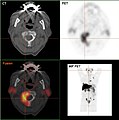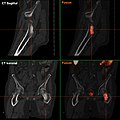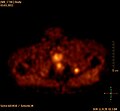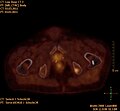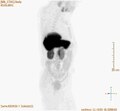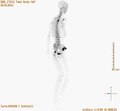Positron emission tomography for bone metastases
The positron emission tomography of bone metastases is a diagnostic method for the detection and assessment of bone metastases .
Representation using FDG
The positron emission tomography (PET) with 18 F-2-fluoro-2-deoxy- D -glucose (FDG) as a radiotracer - the "workhorse" in the oncological PET - is a very efficient method for the determination of many tumor types Metastasis and for the follow-up examination (relapse diagnosis). FDG is a glucose - derivative . After intravenous administration, it is preferentially absorbed by all cells with an increased metabolism. Tumor cells usually have an increased need for glucose due to their increased metabolism compared to healthy cells. These cells enrich FDG because, unlike glucose, it cannot be metabolized due to its modification. When the radioactive fluorine -18 ( 18 F) decays , a positron is created , which after a short time is radiated into two high-energy photons with an electron in the vicinity . The photons are detected by the PET and calculated using the sum of the events to form slice images . During the decomposition, the 18 F becomes 18 O , whereby normal glucose is produced from the FDG, which can be metabolized.
Representation using NaF
Instead of FDG, the radiotracer of fluoride - ion 18 F - , which is superior to FDG-PET in many cases, is suitable for displaying bone metastases . One then speaks of an 18 F-PET or, since sodium is usually used as the counterion , of an 18 F-NaF-PET. After intravenous administration, the fluoride ions diffuse very quickly into the extracellular fluid of the bones, where they slowly form fluorapatite from the hydroxyapatite present there by means of anion exchange . This process preferably takes place in areas where intensive bone remodeling is taking place, for example bone metastases or fractures.
In a study, twice as many bone metastases were detected with 18 F-PET compared to conventional skeletal scintigraphy . The specificity is also significantly higher.
Fluoride-18-PET is therefore currently the most accurate and sensitive method for determining bone metastases.
For the skeletal scintigraphy was 18 F-NaF already used in the 1960s and described for the first time 1,962th In the 1970s it was largely replaced by the 99m technetium-labeled bisphosphonates, which are more suitable for the gamma cameras used in scintigraphy . With the spread of positron emission tomography and above all due to a shortage of molybdenum -99, the starting material for technetium-99m generators , which has persisted since 2008 , this radiotracer is experiencing a kind of renaissance , with the potential of conventional scintigraphy with 99m Tc and replace gamma camera. Fluorine-18 can be produced in a cyclotron , while 99 Mo has to be produced in a nuclear reactor with a high neutron flux.
The two radiotracers FDG and 18 F-NaF can also be administered simultaneously and detected with one scan, thereby combining the advantages of both tracers. The combined application in a PET / CT is even more advantageous.
Bone metastases of prostate cancer
In the case of bone metastases of some tumor entities, especially the primary tumor prostate cancer, FDG-PET is often unsuitable. The uptake of FDG by the cells of the slowly growing skeletal metastases of prostate carcinoma is too low in a large number of patients. In one study, for example, only 65% of the metastases detected by skeletal scintigraphy could be detected by FDG-PET. Other studies arrive at even worse values. Therefore, the radiotracers 18 F-fluoroethylcholine and 18 F-choline are used to visualize prostate cancer . The uptake of choline in these tumor cells is higher than that of glucose. Choline is an important building block for all cells in the formation of phosphatidylcholines , a group of cell membrane- forming phospholipids . Compared to normal cells, prostate cancer cells take up more choline or the 18 F-labeled choline derivatives, which is why these radiotracers - which are related to natural choline - accumulate there. This is not only the case with the cells of the primary tumor of prostate cancer, but also with all of its metastases.
Instead of 18 F-fluoroethylcholine, 11 C-choline, which is chemically identical to natural choline, is occasionally used. However, its handling is much more difficult because of the very short half-life of 20 minutes (compared to just under two hours at 18 F).
- F-18 choline PET / CT
Osteolytic bone metastasis in the second cervical vertebra (axis) of a metastatic prostate carcinoma
CT of a prostate cancer metastasis in the left pubic bone (right in the picture)
- Videos
Maximum intensity projection (MIP) of a PET / CT with choline . The physiological accumulation in the liver, pancreas, kidneys, bladder, spleen, bone marrow and the salivary glands can be clearly seen. The bone metastasis is in the pubic bone on the left.
PET / CT in MIP with 18 fluoro-deoxyglucose (FDG) in metastatic breast cancer. Primary tumor in the right breast. Lymph node metastases in the mediastinum and lung metastases . The bone metastases can be better delineated in the examination with 18 F-NaF (next video).
PET / CT in MIP with 18 F sodium fluoride (NaF) in metastatic breast cancer. Bone metastases in the skull, spine, pelvis, ribs, left collarbone and right thigh. The same patient as in the FDG video
literature
- D. Hellwig, B.-J. Krause, H. Schirrmeister, M. Freesmeier: Skeletal diagnostics using 18 F sodium fluoride PET and PET / CT. DGN - Guideline , Version 1.0 Nuclear Medicine 2010; 49: 195-201 doi : 10.3413 / nukmed-0343
- BJ Krause, U. Driver, S. Schwarzenböck, M. Savatzoglou: Choline-PET / CT for imaging prostate carcinoma. The nuclear medicine doctor 2010; 33: 181-186 doi : 10.1055 / s-0030-1254161
Individual evidence
- ^ AK Shukla, U. Kumar: Positron emission tomography: An overview. In: Journal of medical physics / Association of Medical Physicists of India. Volume 31, Number 1, ISSN 0971-6203 , January 2006, pp. 13-21. doi : 10.4103 / 0971-6203.25665 , PMID 21206635 , PMC 3003889 (free full text).
- ↑ J. Kotzerke, SN Reske: PET imaging (C-11 acetate) . Ulm University Hospital
- ↑ H. Schirrmeister, A. Guhlmann, J. Kotzerke, C. Santjohanser, T. Kühn, R. Kreienberg, P. Messer, K. Nüssle, K. Elsner, G. Glatting, H. Träger, B. Neumaier, C Diederichs, SN Reske: Early detection and accurate description of the extent of metastatic bone disease in breast cancer with fluoride ion and positron emission tomography. In: Journal of clinical oncology Volume 17, Number 8, ISSN 0732-183X , August 1999, pp 2381-2389, PMID 10561300 .
- ↑ M. Blau, W. Nagler, MA Bender: Fluorine-18: a new isotope for bone scanning. In: Journal of nuclear medicine Volume 3, ISSN 0161-5505 , July 1962, pp. 332-334, PMID 13869926 .
- ^ G. Subramanian, JG McAfee: A new complex of 99mTc for skeletal imaging. In: Radiology Volume 99, Number 1, ISSN 0033-8419 , April 1971, pp. 192-196, PMID 5548678 .
- ^ H. Kaulen: Lack of medically usable isotopes . In: faz.net of February 9, 2009.
- ↑ J. Czernin, N. Satyamurthy, C. Schiepers: Molecular mechanisms of bone 18F-NaF deposition. In: Journal of nuclear medicine. Volume 51, Number 12, December 2010, pp. 1826-1829, ISSN 1535-5667 . doi : 10.2967 / jnumed.110.077933 , PMID 21078790 (review).
- ↑ W. Lang Steger, M. Heinisch, I. Fogelman: The role of fluorodeoxyglucose, 18F-dihydroxyphenylalanine, 18F-choline, and 18F-fluoride in bone imaging with emphasis on prostate and breast. In: Seminars in nuclear medicine. Volume 36, Number 1, ISSN 0001-2998 , January 2006, pp. 73-92 doi : 10.1053 / j.semnuclmed.2005.09.002 , PMID 16356797 (Review).
- ^ FD Grant, FH Fahey, AB Packard, RT Davis, A. Alavi, ST Treves: Skeletal PET with 18F-fluoride: applying new technology to an old tracer. In: Journal of nuclear medicine. Volume 49, Number 1, ISSN 0161-5505 , January 2008, pp. 68-78, doi : 10.2967 / jnumed.106.037200 , PMID 18077529 (review).
- ↑ S. Hoegerle, F. Juengling, A. Otte, C. Old Hoefer, EA Moser, EU Nitzsche: Combined FDG and [F-18] fluoride whole-body PET: a feasible two-in-one approach to cancer imaging? In: Radiology. Volume 209, Number 1, ISSN 0033-8419 , October 1998, pp. 253-258, PMID 9769840 .
- ↑ A. Iagaru, E. Mittra, SS Yaghoubi, DW Dick, A. Quon, ML Goris, SS Gambhir: Novel strategy for a cocktail 18F-fluoride and 18F-FDG PET / CT scan for evaluation of malignancy: results of the pilot -phase study. In: Journal of nuclear medicine Volume 50, number 4, ISSN 0161-5505 , April 2009, pp. 501-505, doi : 10.2967 / jnumed.108.058339 , PMID 19289439 .
- ↑ C. Hofer, C. Laubenbacher, T. Block, J. Breul, R. Hartung, M. Schwaiger: Fluorine-18-fluorodeoxyglucose positron emission tomography is useless for the detection of local recurrence after radical prostatectomy. In: European Urology . Volume 36, Number 1, ISSN 0302-2838 , 1999, pp. 31-35, PMID 10364652 .
- ↑ PD Shreve, HB Grossman, MD Gross, RL Wahl: Metastatic prostate cancer: initial findings of PET with 2-deoxy-2- [F-18] fluoro-D-glucose. In: Radiology. Volume 199, Number 3, ISSN 0033-8419 , June 1996, pp. 751-756, PMID 8638000 .
- ↑ SD Yeh, M. Imbriaco, SM Larson, D. Garza, JJ Zhang, H. Kalaigian, RD Finn, D. Reddy, SM Horowitz, SJ Goldsmith, HI Scher: Detection of bony metastases of androgen-independent prostate cancer by PET -FDG. In: Nuclear medicine and biology. Volume 23, Number 6, ISSN 0969-8051 , August 1996, pp. 693-697, PMID 8940712 .
- ↑ The MICAD Research Team: 18F-Fluorocholine. In: Molecular Imaging and Contrast Agent Database (MICAD) PMID 20641761 (as of February 1, 2011)

